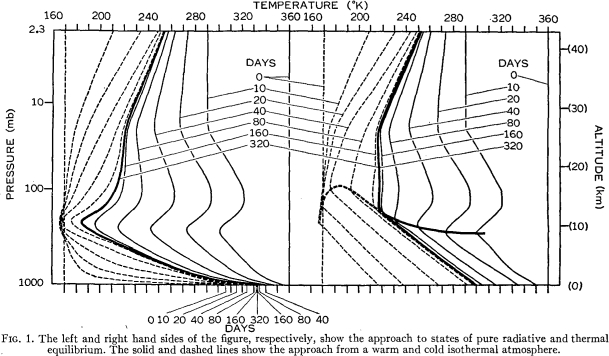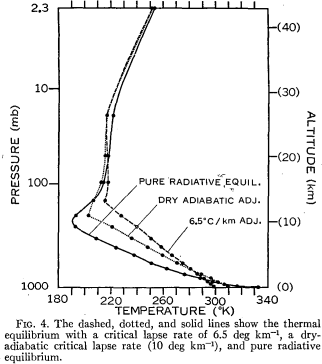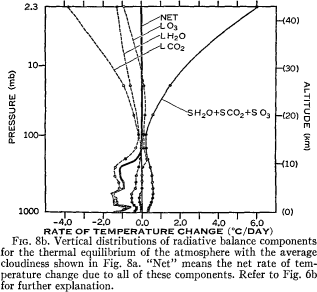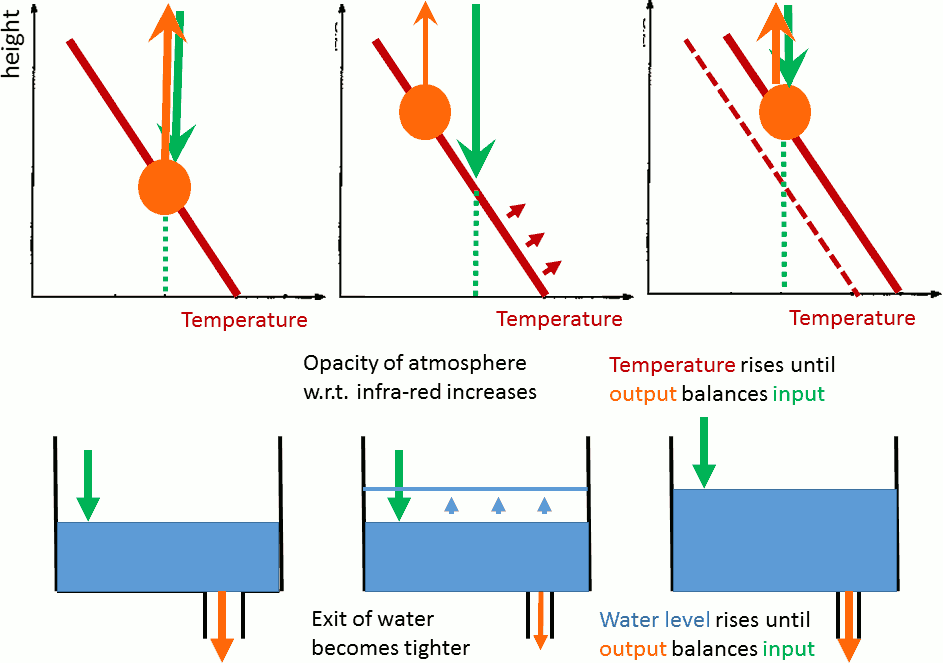Climate change (Class of 2019)
Carbon dioxide and (steady state) climate change
- "Ice ages" (past extent of continental ice sheets, or big glaciers)
- Glacial cycles (20000 years ago vs. present; 100 0000 year cycle)
- Ice ages and ice-less ages in 100 million year time span
- What made climate change?
- Intrinsic variability?
- Forced response?
- Various ideas emerged and disappeared.
- Mechanical forcing, such as lunar tides ... possible, but present science considers it minor.
- Discussion with factors that cause changes in global energy balance seems successful.
- Snow and ice (changing "albedo") ... as feedback rather than forcing
- Activity of the sun
- Aerosols
- from volcanoes ... mineral ("volcanic ash"); sulphuric acid
- air pollution ... soot (black carbon); sulphuric acid, etc.
- mineral dust (natural + from land use change)
- Gaseous components of air (as follows)
- (Note: "anthropogenic" natural causes are mixed here.)
Which components of air interact with radiation?
- Solar radiation (ultraviolet, visible, near infra-red)
- Ozone (O3) ... absorbs ultraviolet, makes photochemical reactions
- (Absorption by water vapor etc. is not negligible, but relatively minor.)
- clouds, aerosols
- Terrestrial radiation (thermal infra-red)
- Gas molecules
- 1-atom molecules (Ar), symmetric 2-atom molecules (N2, O2) do not have intrinsic vibration modes in the frequency range.
- [*]Petty (2006) Figure 9.2 (PDF) Structures of molecules
- [*]Petty (2006) Figure 9.4 (PDF) Vibration modes of molecules
- Asymmetric 2-atom molecules (e.g. CO) has some contribution, but considered minor.
- Molecules composed of 3 or more atmos
- Water vapor (H2O) [variable and temperature-dependent]
- Carbon dioxide (CO2)
- Ozone (O3) [variable and mainly limited to stratosphere]
- Methane (CH4)
- Dinitrogen monoxide (N2O, "nitrous oxide")
- Halocarbons, including chrolofluorocarbons (e.g. CCl3F) [artificial substance]
- [*]Petty (2006) Figure 9.6 (PDF) Absorptivity vs. wavelength; broadening of absorption lines
- clouds, aerosols
Absorption and transmittance of infra-red radiation by the atmosphere
- [*]Petty (2006) Fig 3.3 (PDF) (upper) Blackbody radiation; (lower) absorptivity of cloud-less atmosphere (broad picture).
- [*]Petty (2006) Fig 7.6 (PDF) Transmittance of cloud-less atmosphere. Zenith direction in mid-latitude summer. Contributions of gas components and total.
Reference
- Grant W. Petty (2004, second edition 2006): A First Course in Atmospheric Radiation.
Madison WI USA: Sundog Publishing.
[my note]
"Discovery of global warming" ... development of thoughts
[Historical list (image file)]
- Fourier (of "Fourier transform" (applied math) and theory of heat conduction)
- 1824, 1827: Notion similar to "greenhouse effect" appeared.
- (Notion of "energy" was not emerged yet. so he discussed "heat balance".)
- (Gaseous components were not discussed. Change of climate was not discussed.)
- Tyndall (who also studied scattering of visible light and also glaciers)
- 1863: Water vapor, CO2, methane etc. absorb infra-red radiation (lab. exp.)
and those will be relevant to climate.
- Arrhenius (of the theory of acids and bases in chemistry)
- 1896: Calculation of temperature change (steady-state response) to CO2 doubling
- He also noted CO2 emission by burning coal, but he did not make warning.
- (Influence of Arrehius is found in a fiction by a Japanese writer
MIYAZAWA Kenzi in 1932.
See [another page of mine].)
- Callendar (steam engineer and amateur atmospheric scientist)
- 1938: Suggestion that warming due to fossil fuel CO2 had already happened. (Did not become the majority view.)
- Plass (applied physicist working in military-related research of infra-red radiation)
- 1955: Precise calculation of infra-red absorption/emission by CO2; suggested relevance to climate change
- Question: How strong the effect of CO2 concentration? In particular, steady-state response to CO2 doubling.
- Many scientists tried to calculate by 0-dimensional models, but reliable answers were not available.
- 1957-1958 International Geophysical Year
- Regular observations of carbon dioxide concentration started in Mauna Loa (Hawaii Is.) and the South Pole
- Besides annual cycle, regular increase is evident in several years.
References
- Weart (2003, 2008)
- Archer & Pierrehumbert eds. (2011)
- see books page
Data of carbon dioxide concentration
"ppm" "by volume" ... i.e. ratio of numbers of molecules (rather than ratio of mass)
[x][at World Data Center for Greenhouse Gases (at Japan Meteorological Agency)
[x][at Earth System Research Lab., NOAA, USA]
Precursor of a homework: evaluation of CO2 mass in the atmosphere, given concentration in ppm.
Theoretical computation of vertical temperature profile of the atmosphere [Manabe and Strickler 1964]
"Standard atmosphere": typical vertical distribution of temperature in the real world
Syukuro Manabe finished Ph.D. in 1957 in Japan,
moved to USA and worked in what will be later called Geophysical Fluid Dynamics Laboratory,
National Oceanic and Atmospheric Radiation,
for developing 3-dimensional "general circulation" model of the atmosphere.
During the course, he also made a vertical 1-dimensional model.
- Horizontal dimension: globally averaged condition.
- Vertical dimension: many (e.g. 9 or 18) layers of the atmosphere plus "surface".
- In time: target is a steady state.
To obtain it, time-stepping calculation is made from arbitrary initial conditions.
- In this particular study, water vapor content is fixed (despite temperature change).
Contents of water vapor, CO2, ozone etc. are given as constants based on averages of long-term observations.
- Vertical energy transfer
- First, only radiative transfer (solar and terrestrial) is considered.
- Then, "convection" is added.
Vertical temperature gradient is expressed as "lapse rate", which is positive when the temperature is lower at higher position.
When the lapse rate is larger than a certain critical value (6.5 K/km),
the temperature profile is replaced to have the critical lapse rate
keeping the total energy.



Results
- Temperature in the stratosphere can be explained by radiative balance.
- Absorption of solar radiation (mainly by ozone) - emission of terrestrial radiation (mainly by CO2) = 0
- Temperature in the troposphere can be explained by radiative-convective balance.
- Absorption of solar radiation (by water vapor etc.) - emission of terrestrial radiation (mainly by water vapor and CO2) + convective heating (including condensation of water vapor) = 0
- Temperature gradient in the troposphere is determined by convection.
- (Radiative balance gives too large lapse rate.)
Reference
- Syukuro Manabe and Robert F. Strickler, 1964: Thermal equilibrium of the atmosphere with convective adjustment. Journal of the Atmospheric Sciences, 21: 361-385. [original article]
Effect of CO2 concentration on temperature [Manabe and Wetherald 1967]
- Water vapor content will increase when temperature rises.
The authors included it in the model as
"constant relative humidity",
i.e. water vapor content is proportional to its saturation value (which is dependent on temperature).
- [Graph of saturation specific humidity vs. temperature]
- Steady-states were obtained for several different (constant) values of CO2 concentration.
[Main result of Manabe & Wetherald 1967 (image file)]
- Higher CO2 concentration gives lower stratospheric temperature.
- Higher CO2 concentration gives higher tropospheric (or surface) temperature.
As CO2 concentration is doubled, surface temperature will be 2.3 K higher.
- As CO2 is doubled from any baseline, surface temperature will be higher as the same amount.
i.e. Surface temperature "anomaly" is roughly proportional to the logarithm of CO2 concentration.
- By constant relative humidity,
sensitivity of temperature to CO2 concentration is
roughly twice as large as in the case of constant water vapor content.
Greenhouse effect of water vapor acts as positive feedback to temperature change.
- In this study, effects of clouds were also discussed
by giving several cases of fixed cloud distributions.
Cloud has both effect of reflection of solar radiation
and absorption+emission of terrestrial radiation (greenhouse effect).
In most cases, reflection of solar radiation is dominant.
In thin upper-tropospheric clouds (cirrus), greenhouse effect can be dominant.
Rerefence
- Syukuro Manabe and Richard T. Wetherald, 1967: Thermal equilibrium of the atmosphere with a given distribution of relative humidity. Journal of the Atmospheric Sciences, 24: 241-258. [original article]
Explanation of greenhouse effect based on quasi-steady-states (by Manabe)
Approximate that emission of terrestrial radiation to space comes from a certain single height level.
With more greenhouse gases, effective source height of terrestrial radiation shifts to higher position.
(The atmosphere becomes more "opaque" to infra-red.)
Assuming that incoming solar radiation and its absorption by the climate sysem do not change,
"effective radiative temperature of the earth" Te does not change.
The temperature must much Te at a higher position than before.
So, the surface temperature must be higher than before.

2019-May-23
MASUDA Kooiti




